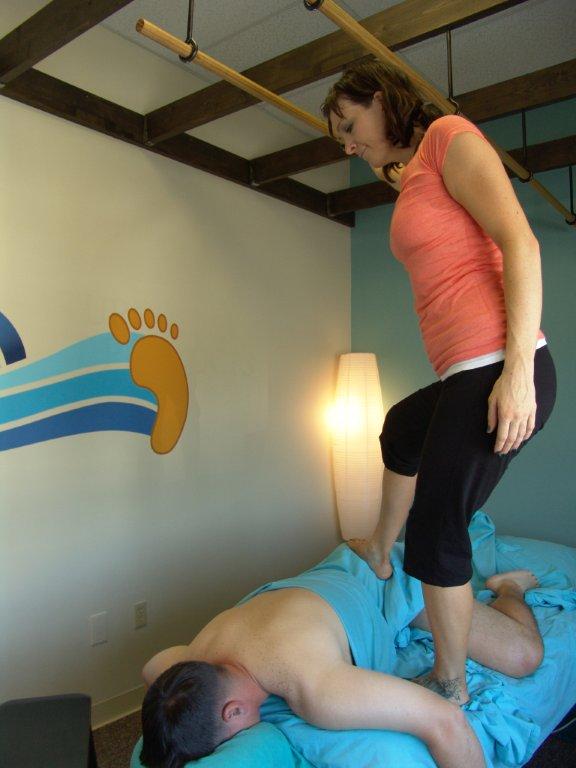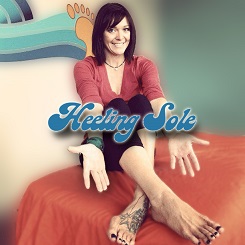According to the legend, Thai Massage was founded by Shivago Komarpaj who was Buddha’s physician. Thai massage is definitely one of the more ancient massage therapy practices, and it absorbed Hindu and Chinese healing concepts. We think that our readers will find this article interesting since it offers a different view on the practice of sports massage that we are accustomed to here in the West.
ASHIATSU BAREFOOT MASSAGE AS A FORM OF SPORTS THERAPY
My experience in massage and Thai bodywork stems from a background in modern dance and yoga. Years of dance training combined with Yoga and Pilates helped me to develop a healthy curiosity and awareness of the body in space. I was encouraged to use passive, active and assisted stretches to stay ready for performance and prevent injury. When I became a massage therapist, I learned (and am still learning!) the deeper meaning behind what seemed like a simple, daily stretching routine all those years ago.
I now specialize in Barefoot Massage techniques such as Ashiatsu and Thai massage. I instantly connected to these modalities not only for the artistic expression I see in the flowing movements that dance across the clients body, but mainly for the many hidden aspects of therapeutic and sports massage happening underfoot. Applying elements of deep tissue, fascial work, trigger point, with active, passive and assisted stretching into a massage session has helped me to assist my physically active clients with their weekly muscle-recovery routine.
I am going to discuss some effects of barefoot massage, and compare it to what is more commonly understood of hands-on bodywork. We all know the benefits of sports therapy-boosts performance, breaks down scar tissue, prevents injuries and loss of mobility, reduces delayed onset muscle soreness, decreases anxiety, enhances microcirculation, improvement of tissue elasticity-there are so many great aspects. The same results can be achieved with Ashiatsu, since this style of barefoot massage includes a dynamic range of additional benefits for the sporting life.
I know what a reader may be thinking: Ashi-what!? It is pronounced “Ahhh-shiatsu.” “Ashi” means foot, and “-atsu” is pressure. In this style of massage, the therapist uses gravitational force and distributes his or her body weight by holding onto bars in the ceiling and using the feet to deliver the strokes and apply painless pressure directly onto the client’s body. Ashiatsu is not just walking on the client’s back; the client will feel a deep, broad, flowing centrifugal pressure that engages the fascia throughout the entire body, loosening adhered tissue, increase drainage. Additionally, careful compression of soft tissue is applied throughout the session, helping to release muscle spasm and tension, always working within the clients’ comfort zone. It works fast. In my practice I’ve noticed that typically just 20 minutes of Ashiatsu accomplishes the physical benefits that occur in a 60-minute session of a more traditional style of hands-on bodywork.
I have found that Ashiatsu’s effectiveness comes from treating all layers of the tissue and the entire body as a whole, which results in a calming of the “fight-or-flight” response of the sympathetic nervous system and peripheral vasodilation. By massaging the larger surface area of a foot-in comparison to a hand or forearm-and by accessing the deeper layers of soft tissue without the sensation of pokey pain that triggers muscle guarding, the rate of post-event recovery after strenuous exercise increases.
The depth of pressure is consistent throughout the entire length of the muscle. Curbing the pain responses and flooding the body with new sensory stimulation helps it re-evaluate itself and speeds up the athlete’s recovery. To boost pre- or post-workout low intensity exercise, passive Thai stretches are incorporated to improve tissue elasticity and reduce initial tension.
Ashi-Thai-another form of barefoot massage developed from Ashiatsu and Thai massage-offers a unique chance to rest, relax and recuperate from strenuous activities while the therapist maneuvers the client’s limbs and body into deep stretches that the client may not be able to achieve alone. The advantage of this massage, both for the client and the therapist, is that Ashiatsu and Ashi-Thai allows gravity to do the work, balancing the therapists’ body weight to provide a depth and leverage unmatched by other techniques.
Ashi-Thai is an effective bodywork treatment for overused and tensed soft tissues. Most clients report significant decreases in pain and significant increases in range of motion and athletic performance. Clients with sports or repetitive-strain injuries receiving Ashi-Thai often find they are even more flexible after the sessions than before the tissues were strained!
If the Psoas needs to be stretched, IT Band unbound, or the Soleus/Gastrocs released, this massage will do it. The benefits of Ashiatsu combined with the passive stretching techniques that are included in Ashi-Thai offer a well-rounded holistic approach that aid in improving the client’s performance and maintaining overall good health.
Here is an example of strokes that can be used for a runner complaining of “tight hips,” as they usually say. With the client positioned on the table in a prone Vrksasana, or what is known as “Tree Pose” in yoga, the Hip Hiker series of strokes that can be done with either a gliding compression, Ashiatsu style when used with some lubricant directly on the skin, or simply done with compression through clothing, Ashi-Thai style (see Fig. 1). Either way, the practitioner will be working to lengthen the Pectineus, Adductor Longus and Brevis without even touching them. The weight delivered from this work provides a yin-yang approach when addressing the hip: the therapist compresses posteriorly to stretch anteriorly, and vice versa.

Fig. 1. Ashiatsu for the hip adductors
A rolling-downward compression applied between the greater trochanter and iliac crest on the bent leg side will traction the hip and open the anterior hip capsule, while the client is passively positioned to encourage a deeper outward rotation of the leg. If the practitioner uses gliding strokes, this traction can turn into a slide through TFL and the IT Band, and on down over the lower leg with broad pressure over the Fibula, approximating it slightly towards the Tibia to help give a moment of slack to the interosseous membrane in between.
This technique is also indirectly working Psoas. This is especially true in a similarly positioned move called “Figure 4 from Ashi-Thai.” From the same Tree Pose positioning, the practitioner flexes the knee of the leg that has since laid straight and relaxed on the table. While continuing to apply rhythmic pressure to the rotated bent leg, the opposite side leg is rocked, which adds an element of slight lumbar extension in some, but mainly a stretch to the Rectus Femoris. The practitioner can control the orientation of the pelvis with one foot on the body, pushing with an angle of pressure to reduce or increase the pelvic tilt as needed (see Fig. 2).

Fig. 2. Ashiatsu for the iliopsoas and rectus femoris muscles
Posteriorly tilting will really increase the sensation of a deeper stretch to what is already happening in both legs. When it is time to make like a pancake and flip, the client turns over for Ashi-Thai’s “Pretzel” while supine.
A crowd favorite, it is just like Eka Pada Rajakapotasana, or “Pigeon” from yoga! Here the therapist stretches the deep six rotators (Piriformis, Obtrurators, Gemelli and Quadratus Femoris) and the more superficial Glutes (see Fig. 3). What was just being compressed during the prone Hip Hiker series is now being lengthened. Clients love this stretch!

Fig. 3. Ashiatsu for hip rotators
Another chance to pry open the hips occurs during the “Tree” stretch while the client is supine, which is another amazing move from Ashi-Thai. This move uses broad compressions and a long static hold, and, on some clients, the practitioner will even have the opportunity to apply his or her entire body weight to soften up Adductor Magnus, Adductor Longus, Gracilis, and Sartorius, and see those hips blossom open like a beautiful Lotus flower.
Ashi is so much MORE than just the catch phrase “deepest, most luxurious massage on the planet.” I am continually learning about massage, and this work never ceases to amaze me. To successfully practice these types of bodywork, the therapist must obtain the correct training. This style of Barefoot Massage should be learned first from a qualified instructor before the practitioner can work on clients. When properly trained, the therapist will find out how to blend deep tissue techniques with the sports massage style of passive stretching-ALL WITH YOUR FEET!
If you are interested in learning Ashiatsu, please visit: www.TexasAshiatsu.com

Jeni Spring has been an associate instructor for the Ashiatsu Barefoot Bar Group since 2008, and is the owner of Heeling Sole Barefoot Massage in San Antonio, Texas. She rides scooters, does lots of yoga, and watches Roller Derby.
Category: Sport Massage
